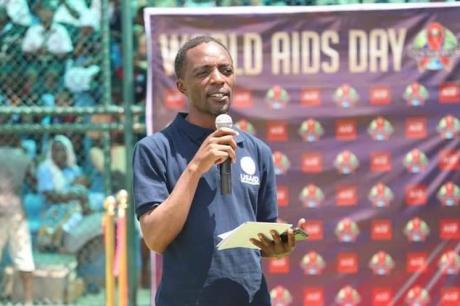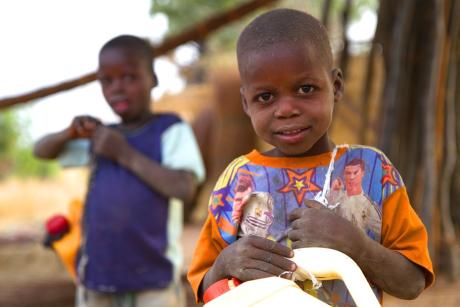
An Ebola prevention educational poster at the INRB
Published September 22, 2014, last updated on June 3, 2020 under Voices of DGHI
Chelsea McMullen
MSc-GH Candidate
My first night in Kinshasa, I stood on the porch overlooking the city. With its tall buildings, paved but dusty roads, and fashionable people, it was nothing like what I had expected.
That was when I heard it: screech screech. I looked up and saw my first bat.
WHO’s response to uncharted territory
I had the incredible opportunity to be an intern at WHO during their initial response to the world’s largest Ebola outbreak currently ongoing in West Africa. Director-General Margaret Chan’s decision to declare it a Public Health Emergency of International Concern sent the whole organization into action. People were taking leave of their assigned positions to help with Ebola mission logistics, procurement, education, clinical care, and much more. The entire staff was briefed, because as the leading health organization in the world, we needed to have correct information in order to provide education, not only to West Africans, but also to a very nervous world.
Cases of Ebola, whose natural host reservoir is thought to be a bat, went undiagnosed for over three months in Guinea, misclassified as cholera or Lassa fever or some other less lethal illness. By the time health officials realized what they were dealing with, it had already weaved its way through the country and into the capital of Conakry. Ebola has always been confined to remote, forested regions, which were easy to quarantine until the virus had no one left to infect. But the densely populated Conakry was a setting that even the world’s Ebola experts were ill-equipped to deal with.
We will do better now
At the WHO staff briefing, I was humbled to hear officials admit that mistakes had been made, that they were unsure how to handle this outbreak at first. The Ebola Response Roadmap released in August is a compilation of knowledge gained during the first two months of response - knowledge that did not exist before that. ‘We will do better now,’ they said.
The Congolese response
Just days before leaving for my fieldwork in Congo, I received word that a new, unrelated Ebola outbreak had started there, in Boende, not far from the first outbreak site in 1976. Since then, Congo has seen seven more outbreaks; more than any other country in the world. After some serious discussions, it was decided that I would carry through with my original plans, unless the virus reached Kinshasa. This event was unlikely not only because Congo has experience controlling Ebola, but also because transportation is very, very limited here. There are no roads between Boende and Kinshasa; only the river, which takes days to travel by. The small air companies who charter flights to the region suspended travel. The virus is trapped there.
I am very lucky, in a twisted epidemiologist way, to have also been witness to the Congolese response efforts to Ebola. My first week in Congo, I stayed in Kinshasa with two American PhD candidates who are helping with our project. They work at the Institut National de Recherche Biomedicale (INRB), the national laboratories of DRC, and supplied the officials heading to the field with yoga mats and mosquito nets.
One of the scientists who came to pick up the supplies was the one who had determined the strain of this new outbreak just days before. While talking with him, I was both inspired and saddened. He was so enthusiastic that Congo has the potential to become a world leader in the control of Ebola and future outbreaks of new viruses, but the inconsistently funded health system, poor infrastructure, and fragmented supply chain prevents the country from reaching that potential.
As we learned from the mistakes made in West Africa, it is essential that countries immediately put pride aside, and ask for international assistance to control the outbreak while it is still small. Congolese scientists know this, and while it is has been effective, there are many downsides to this approach to infection control. For example:
- Health centers receive huge shipments of supplies. However, there have been instances when these centers continue to spread the infection. Why? Because when the outbreak is over, they may not receive another shipment for a long time. Therefore, they still reuse gloves and other protective equipment, so their current supply will last as long as possible.
- Foreign medical teams bring their own lab equipment to the field to diagnose positive cases. When the outbreak is over, they bring this equipment back with them. The ability to respond is not homegrown, and not sustainable in the case that international organizations are unavailable to help.
A baby named Ebola
The aversion to Ebola is obvious in the general Congolese population. While buying material for some work uniforms in a narrow, crowded fabric market, I so much as touched the side of my nose when a young woman screamed at me in French “No, no! Don’t touch your face; you may catch Ebola!!!” I thanked her and was much more careful after that.
At the Lola ya Bonobo, the primate sanctuary where I am working, the precautions are subtle, but noticeable. Instead of handshakes, you see elbow bumps, and instead of kisses on the cheek, you see the touching of foreheads.
A new baby bonobo arrived last week. He was very malnourished, and obviously sick with parasites, congestion and a cough. According to protocol, he must be tested for hepatitis, Simian Immunodeficiency Virus (the primate version of HIV), and tuberculosis. He was captured from a region within 100km of the ongoing Ebola outbreak, so it is necessary that he also be tested for that. However, he was sold to a family in Kinshasa two weeks ago and would surely have died already if he were infected. Even so, none of the Congolese “mamas” who usually care for the babies want to touch him until after the tests come back negative. They even joked about naming him “Ebola!”
How can we prevent future outbreaks?
The American PhD’s would have eagerly volunteered to go to the outbreak site, but the Congolese doctors wanted to avoid it like the plague, which is wise; it is much worse than the plague. They are more intimately familiar with this disease and have more respect for its lethality. They know how they need to respond to an outbreak in their current situation, but with the prospect of new and deadly viruses continuing to emerge, it is essential that all health systems be prepared to deal with epidemics on a national level. This means adequate and timely reporting of cases, a functioning supply chain, technology transfers for lab equipment, and of course, more training for health professionals. The absence of such factors has led to the situation we are witnessing right now in West Africa, and unless we address these weaknesses, similar events may continue to occur.


